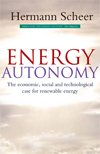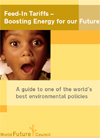 Speech of Dr. Hermann Scheer, President of EUROSOLAR, at the Closing Session of the European Congress on Renewable Energy Implementation, Athens, May 7th, 1997
Speech of Dr. Hermann Scheer, President of EUROSOLAR, at the Closing Session of the European Congress on Renewable Energy Implementation, Athens, May 7th, 1997The fault of the “energy discussion” lies in the assumption that it is an energy discussion. We can speak a lot and endlessly on the desastrous consequences and social costs of climate change. But if the discussion arrives at concrete figures, the chorus of contemporate economists is asking for competetiveness.
There is a legitimacy to rise this question for a single company in competition with others. But if this microeconomic approach became the main criteria of public authorities and including international institutions we will get a transformation from macro- to microeconomics - a microeconomisation of the world: global action with small and isolated thinking - an economy of intellectual dwarfs in front of gigantic problems.
The energy statistics are such a small approach. The existing statistics which I know of are wrong.
They ignore many aspects of solar energy.
- Humans (active energy converters) are not directly involved, the food is ignored (in contrast to the more comprehensive energy statistics of the 19th century), the use of passive solar energy is not really counted (if someone reconstructs his house to passive solar, he will be immediatly deleted from the statistics.)
- Most energy statistics are cash-flow statistics of commercial energies and not energy statistics. They can never tell the truth.
- The fact is that solar energies were at any time - even since the industrial revolution - the main energy basis. Fossil energies and nuclear energies are additional energies for a limited time - and the time begins to run out in three of four conventional sources until the mid of the next century.
- limits of availability
- marginal source: the problem is: we made mankind dependent on this marginal source - we are running for the margilization of mankind. Marginalized by limits of availability, environmental changes and increasing international conflicts.
- the curve of availability of limited sources is descending; the curve of energy demand is rising.
- crosspoint: bloody conflicts
What do we have to learn?
1. Energy is too important to leave it to the energy economy and the energy departments. This tradition was introduces with the fossil and nuclear energy suppliers.
Renewable energies have multiple economic functions: They meet direct energy needs, save the natural environment, eliminate running costs for private households and regional and national economics, have two functions in one in the case of solar facades or solar roofs, promote health quality, reduce international tensions and protect the oil sources.
An integrated path needs agricultur-, construction- and traffic-policies.
2. Creating new supporters to get from few to many suppliers. We need independent private producers and we have to get from the private home level to a companies and municipalties level. We have to overcome the planning economy of the energy sector, that means a structural change based in overcoming market-barriers and subsidies for conventional energies
The change can come faster than everybody expects.



